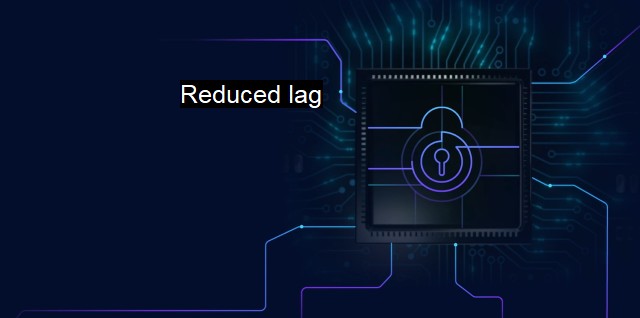What is Reduced lag?
Maximizing System Performance: The Importance of Reduced Lag in Cybersecurity and Antivirus Protection
Reduced lag, within the context of cybersecurity and antivirus software solutions, is a significant consideration for individuals and businesses. Broadly, lag means the slowing down of computer functions, which can be a result of various issues such as a lack of processing power, malfunctioning hardware, or inefficient software operations. Within the cybersecurity context, reduced lag signifies enhancing computer performance by minimizing delays associated with antivirus operations.Most individuals and businesses use antivirus software to protect their data and systems from cyber-attacks. These software aid in detecting, deterring, and removing potentially harmful programs that could compromise the security of their digital elements. Top-tier antivirus systems scan files, emails, downloads, and web pages for malware continually. They check against databases of known threats, employ heuristics to identify unknown potentials threats, and safeguard the system by either quarantining or eliminating found threats.
While essential, this antivirus operation comes at a drawback. When excessive time is taken to execute these functions, lag can occur. This lag not only influences system performance but can disrupt user interactions and interfere with business processes. Thus, the reduction of this lag in antivirus and cybersecurity operations is quite crucial.
Cybersecurity and antivirus programs fall into two categories: traditional and next-generation. Traditional antivirus systems involve a trade-off between security and system efficiency, causing lag. They rely on resource-intensive activities, such as signature-based detection that requires continually updated databases. Updating these databases require high amounts of processing power, which results in performance bottlenecks, manifesting as slow response times, frequent hangs, or crashes.
Next-generation antivirus software, on the other hand, focuses on reducing lag through advanced techniques. These often have artificial intelligence and machine learning algorithms that process threats much faster, reducing the need for constant updates. They incorporate behavioural detection techniques and sandboxing. Behavioural detection watches how files behave, rather than relying on a threat database, thus shaving off processing time. Sandboxing allows suspicious files to play out in a safe space and studies their behavioural pattern, without affecting the performance of the rest of the system.
These next-generation cybersecurity solutions utilize cloud-based scanning and threat detection. Offloading the processing to cloud servers significantly reduces the computational load on user systems, contributing to less lag while not compromising on security.
In an era where digital dependency and cyber threats are on the rise, seamless cybersecurity solutions are imperative. users also necessitate a system that runs smoothly, valuing speed and performance. To this end, reduced lag using intelligent, learning-based cybersecurity can balance the scales of security and speed. These optimizations in modern-day antivirus software not only enhance the user experience but also underpin smooth business operations, saving time, money, and potential disruption from cyber threats.
Therefore, reduced lag in cybersecurity and antivirus refers to more expansive, smart protection features that enable high performance while giving round-the-clock, robust security. By providing rapid malware detection and elimination, without draining system resources ensures maintaining the significant level of ever-needed but often invisible protection.
The key to reduced lag is evolving smarter and leaner systems, taking advantage of newer technologies. With reduced lag, cybersecurity solutions can enhance the user experience by maintaining fluid operations, reassuring users that their systems are secured effectively, and seamlessly augmenting digital security. This connectivity-enhanced era, where prompt responses are highly valued, reduced lag is not merely a convenience; it’s a necessity.

Reduced lag FAQs
What is reduced lag in the context of cybersecurity and antivirus?
Reduced lag in cybersecurity and antivirus refers to the optimization of the software to reduce the delay or latency in system response time. It means that the antivirus software will not slow down your system, allowing it to run smoothly while still providing real-time protection against cyber threats.How does reduced lag impact the performance of my system while using an antivirus?
Reduced lag helps to maintain the performance of your system while running an antivirus. You can continue to use your computer effectively, without experiencing slow speed or system crashes. It also allows the antivirus software to scan your system and detect malware promptly without affecting the computer's performance.Does reduced lag compromise the effectiveness of an antivirus?
Reduced lag does not compromise the effectiveness of an antivirus. The software is optimized to work in the background, providing real-time protection against cyber threats without slowing down your system. It ensures the antivirus software scans and detects malware quickly, providing robust protection with minimal impact on system performance.Are there any antivirus programs that offer reduced lag?
Many antivirus programs offer reduced lag through optimization of the software. Antivirus programs such as Norton, McAfee, and Bitdefender have optimized their software for minimal impact on system performance while providing robust protection against cyber threats. It is essential to choose an antivirus program that provides reduced lag to maintain your system's performance while ensuring maximum cybersecurity protection.| | A | | | B | | | C | | | D | | | E | | | F | | | G | | | H | | | I | | | J | | | K | | | L | | | M | |
| | N | | | O | | | P | | | Q | | | R | | | S | | | T | | | U | | | V | | | W | | | X | | | Y | | | Z | |
| | 1 | | | 2 | | | 3 | | | 4 | | | 7 | | | 8 | | |||||||